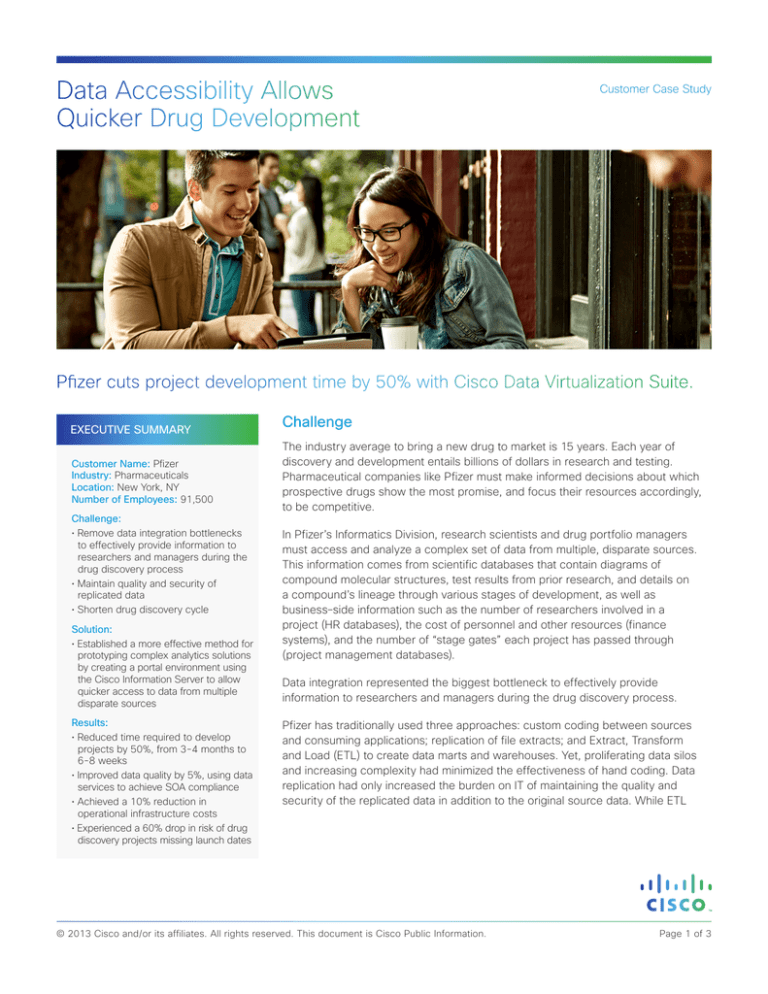
Data Accessibility Allows
Quicker Drug Development
Customer Case Study
Pfizer cuts project development time by 50% with Cisco Data Virtualization Suite.
EXECUTIVE SUMMARY
Customer Name: Pfizer
Industry: Pharmaceuticals
Location: New York, NY
Number of Employees: 91,500
Challenge:
• Remove data integration bottlenecks
to effectively provide information to
researchers and managers during the
drug discovery process
• Maintain quality and security of
replicated data
• Shorten drug discovery cycle
Solution:
• Established a more effective method for
prototyping complex analytics solutions
by creating a portal environment using
the Cisco Information Server to allow
quicker access to data from multiple
disparate sources
Results:
• Reduced time required to develop
projects by 50%, from 3-4 months to
6-8 weeks
• Improved data quality by 5%, using data
services to achieve SOA compliance
• Achieved a 10% reduction in
operational infrastructure costs
• Experienced a 60% drop in risk of drug
discovery projects missing launch dates
Challenge
The industry average to bring a new drug to market is 15 years. Each year of
discovery and development entails billions of dollars in research and testing.
Pharmaceutical companies like Pfizer must make informed decisions about which
prospective drugs show the most promise, and focus their resources accordingly,
to be competitive.
In Pfizer’s Informatics Division, research scientists and drug portfolio managers
must access and analyze a complex set of data from multiple, disparate sources.
This information comes from scientific databases that contain diagrams of
compound molecular structures, test results from prior research, and details on
a compound’s lineage through various stages of development, as well as
business–side information such as the number of researchers involved in a
project (HR databases), the cost of personnel and other resources (finance
systems), and the number of “stage gates” each project has passed through
(project management databases).
Data integration represented the biggest bottleneck to effectively provide
information to researchers and managers during the drug discovery process.
Pfizer has traditionally used three approaches: custom coding between sources
and consuming applications; replication of file extracts; and Extract, Transform
and Load (ETL) to create data marts and warehouses. Yet, proliferating data silos
and increasing complexity had minimized the effectiveness of hand coding. Data
replication had only increased the burden on IT of maintaining the quality and
security of the replicated data in addition to the original source data. While ETL
© 2013 Cisco and/or its affiliates. All rights reserved. This document is Cisco Public Information.
Page 1 of 3
Customer Case Study
“Cisco is helping our group
literally shave years off the
drug R&D process.”
Dan Eng
Project Manager
Pfizer Global Research and Development,
Informatics Division
effectively integrated data for large–scale, multi–dimensional analysis, its
development typically required weeks or months to complete, with the resulting
data often out–of–date. Between the administrative complexity and difficulty in
getting at the underlying sources, Pfizer averaged three to four months to
complete its design, development, test, and deployment phases.
Further, none of these traditional approaches fit easily into Pfizer’s new service–
oriented architecture (SOA) strategy that emphasizes creating data objects
for reuse.
Solution
The Cisco Information Server was implemented, allowing Pfizer’s overall data
integration capabilities to expand to data virtualization, data abstraction and data
federation across both SOA and non–SOA environments. The scientist workbench
can now support both build and run–time requirements.
With the establishment of an easy–to–use development environment, data can be
abstracted in the form of relational views for reporting as well as Web services for
SOA initiatives. The high–performance query engine securely accesses, federates
and delivers the diverse, distributed data to consuming solutions in real–time. Users
now gain on–demand data for quicker decision–making.
With this solution, new capabilities and benefits are available to Pfizer’s Research
Scientists Workbench including:
• Automated data–level development, freeing developers to work on application–
level development while reducing the total development time in half
• Drag–and–drop development environment, built-in security and automated
generation of Web services, requiring fewer specialized skills
• SOA–compliant Web Services Description Language (used for describing the
functionality offered by a web service) data services providing data in the form
needed by portal developers
• Loosely coupled data services that are easier to maintain than ETL and data
delivery scripts when changes are made to the underlying data sources or
the portal
• Reusable data service assets
Results
• Reduced time required to develop projects by 50%, from 3-4 months to
6-8 weeks
• Improved data quality by 5%, using data services to achieve SOA compliance
• Achieved a 10% reduction in operational infrastructure costs
• Experienced a 60% drop in risk of drug discovery projects missing launch dates
© 2013 Cisco and/or its affiliates. All rights reserved. This document is Cisco Public Information.
Page 2 of 3
Customer Case Study
For More Information
To find out more about Cisco Data Virtualization, go to:
http://www.cisco.com/en/US/netsol/ns340/ns394/ns224/
Services List
• Cisco Data Virtualization
Americas Headquarters
Cisco Systems, Inc.
San Jose, CA
Asia Pacific Headquarters
Cisco Systems (USA) Pte. Ltd.
Singapore
Europe Headquarters
Cisco Systems International BV Amsterdam,
The Netherlands
Cisco has more than 200 offices worldwide. Addresses, phone numbers, and fax numbers are listed on the Cisco Website at www.cisco.com/go/offices.
Cisco and the Cisco Logo are trademarks of Cisco Systems, Inc. and/or its affiliates in the U.S. and other countries. A listing of Cisco’s trademarks can be found at
www.cisco.com/go/trademarks. Third party trademarks mentioned are the property of their respective owners. The use of the word partner does not imply a partnership
relationship between Cisco and any other company. (1005R)
© 2013 Cisco and/or its affiliates. All rights reserved. This document is Cisco Public Information.
Page 3 of 3




